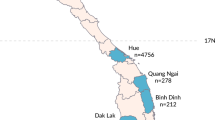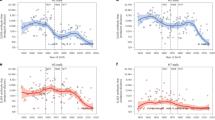Abstract
Pandemic influenza viruses often cause severe disease in middle-aged adults without preexisting comorbidities. The mechanism of illness associated with severe disease in this age group is not well understood1,2,3,4,5,6,7,8,9,10. Here we find preexisting serum antibodies that cross-react with, but do not protect against, 2009 H1N1 influenza virus in middle-aged adults. Nonprotective antibody is associated with immune complex–mediated disease after infection. We detected high titers of serum antibody of low avidity for H1-2009 antigen, and low-avidity pulmonary immune complexes against the same protein, in severely ill individuals. Moreover, C4d deposition—a marker of complement activation mediated by immune complexes—was present in lung sections of fatal cases. Archived lung sections from middle-aged adults with confirmed fatal influenza 1957 H2N2 infection revealed a similar mechanism of illness. These observations provide a previously unknown biological mechanism for the unusual age distribution of severe cases during influenza pandemics.
This is a preview of subscription content, access via your institution
Access options
Subscribe to this journal
Receive 12 print issues and online access
$259.00 per year
only $21.58 per issue
Buy this article
- Purchase on SpringerLink
- Instant access to full article PDF
Prices may be subject to local taxes which are calculated during checkout




Similar content being viewed by others
References
Morens, D.M., Taubenberger, J.K. & Fauci, A.S. Predominant role of bacterial pneumonia as a cause of death in pandemic influenza: implications for pandemic influenza preparedness. J. Infect. Dis. 198, 962–970 (2008).
Tumpey, T.M. et al. Characterization of the reconstructed 1918 Spanish influenza pandemic virus. Science 310, 77–80 (2005).
Itoh, Y. et al. In vitro and in vivo characterization of new swine-origin H1N1 influenza viruses. Nature 460, 1021–1025 (2009).
Kobasa, D. et al. Aberrant innate immune response in lethal infection of macaques with the 1918 influenza virus. Nature 445, 319–323 (2007).
Geiss, G.K. et al. Cellular transcriptional profiling in influenza A virus–infected lung epithelial cells: the role of the nonstructural NS1 protein in the evasion of the host innate defense and its potential contribution to pandemic influenza. Proc. Natl. Acad. Sci. USA 99, 10736–10741 (2002).
Kash, J.C. et al. Genomic analysis of increased host immune and cell death responses induced by 1918 influenza virus. Nature 443, 578–581 (2006).
Taubenberger, J.K. & Morens, D.M. 1918 influenza: the mother of all pandemics. Emerg. Infect. Dis. 12, 15–22 (2006).
Simonsen, L. et al. Pandemic versus epidemic influenza mortality: a pattern of changing age distribution. J. Infect. Dis. 178, 53–60 (1998).
Morens, D.M. & Fauci, A.S. The 1918 influenza pandemic: insights for the 21st century. J. Infect. Dis. 195, 1018–1028 (2007).
Perez-Padilla, R. et al. Pneumonia and respiratory failure from swine-origin influenza A (H1N1) in Mexico. N. Engl. J. Med. 361, 680–689 (2009).
Chowell, G. et al. Severe respiratory disease concurrent with the circulation of H1N1 influenza. N. Engl. J. Med. 361, 674–679 (2009).
Hancock, K. et al. Cross-reactive antibody responses to the 2009 pandemic H1N1 influenza virus. N. Engl. J. Med. 361, 1945–1952 (2009).
Centers for Disease Control and Prevention (CDC). Serum cross-reactive antibody response to a novel influenza A (H1N1) virus after vaccination with seasonal influenza vaccine. MMWR Morb. Mortal. Wkly. Rep. 58, 521–524 (2009).
The ANZIC Influenza Investigators. Critical care services and 2009 H1N1 influenza in Australia and New Zealand. N. Engl. J. Med. 361, 1925–1934 (2009).
Bhat, N. et al. Influenza-associated deaths among children in the United States, 2003–2004. N. Engl. J. Med. 353, 2559–2567 (2005).
Thompson, W.W. et al. Influenza-associated hospitalizations in the United States. J. Am. Med. Assoc. 292, 1333–1340 (2004).
Delgado, M.F. et al. Lack of antibody affinity maturation due to poor Toll-like receptor stimulation leads to enhanced respiratory syncytial virus disease. Nat. Med. 15, 34–41 (2009).
Reichert, T., Chowell, G., Nishiura, H., Christensen, R.A. & McCullers, J.A. Does glycosylation as a modifier of original antigenic sin explain the case age distribution and unusual toxicity of pandemic novel H1N1 influenza? BMC Infect. Dis. 10, 5 (2010).
Mauad, T. et al. Lung pathology in fatal novel human influenza A (H1N1) infection. Am. J. Resp. Crit. Care. Med. 181, 72–79 (2010).
Kobasa, D. et al. Enhanced virulence of influenza A viruses with the haemagglutinin of the 1918 pandemic virus. Nature 431, 703–707 (2004).
Perrone, L.A., Plowden, J.K., García-Sastre, A., Katz, J.M. & Tumpey, T.M. H5N1 and 1918 pandemic influenza virus infection results in early and excessive infiltration of macrophages and neutrophils in the lungs of mice. PLoS Pathog. 4, e1000115 (2008).
de Jong, M.D. et al. Fatal outcome of human influenza A (H5N1) is associated with high viral load and hypercytokinemia. Nat. Med. 12, 1203–1207 (2006).
Lewis, D.E., Gilbert, B.E. & Knight, V. Influenza virus infection induces functional alterations in peripheral blood lymphocytes. J. Immunol. 137, 3777–3781 (1986).
Greenbaum, J.A. et al. Preexisting immunity against swine-origin H1N1 influenza viruses in the general human population. Proc. Natl. Acad. Sci. USA 106, 20365–20370 (2009).
Johnson, T.R. et al. Priming with secreted glycoprotein G of respiratory syncytial virus (RSV) augments interleukin-5 production and tissue eosinophilia after RSV challenge. J. Virol. 72, 2871–2880 (1998).
Polack, F.P. et al. A Role for immune complexes in enhanced respiratory syncytial virus disease. J. Exp. Med. 196, 859–865 (2002).
Regele, H. et al. Endothelial C4d deposition is associated with inferior kidney allograft outcome independently of cellular rejection. Nephrol. Dial. Transplant. 16, 2058–2066 (2001).
Hall, C.B., Douglas, R.G., Simons, R.L. & Geiman, J.M. Interferon production in children with respiratory syncytial, influenza and parainfluenza virus infections. J. Pediatr. 93, 28–32 (1978).
Salomon, R., Hoffmann, E. & Webster, R.G. Inhibition of the cytokine response does not protect against lethal H5N1 influenza infection. Proc. Natl. Acad. Sci. USA 104, 12479–12481 (2007).
Palacios, G. et al. Streptococcus pneumoniae coinfection is correlated with the severity of H1N1 pandemic influenza. PLoS ONE 4, e8540 (2009).
Acknowledgements
Funded by the Fundacion INFANT 2008 Fundraising Campaign and AI-054952 (F.P.P.), the Thrasher Research Fund Early Career Award and Fogarty International Center International Clinical Research Fellows Program at Vanderbilt (R24 TW007988) (G.A.M. and J.P.B.), US Department of Defense grant HDTRA1-08-10-BRCWMD-BAA and US National Institutes of Health grant P01 AI058113 (J.E.C. Jr.). Doctoral awards from the Consejo Nacional de Investigaciones Cientıficas y Técnicas, Argentina (A.C.M. and J.P.B.).
Author information
Authors and Affiliations
Contributions
F.P.P., G.A.M., K.M.E., J.D.C., J.E.C. Jr., J.V.W., A.C.M., J.P.B. and M.F.L. designed the project. A.C.M., J.P.B., M.F.L., J.Z.H., B.M., L.D., K.P.W., J.V.W., G.A.M. and F.P.P. performed experiments. J.C.K., J.K., J.B., C.R., Le. A., L.D., R.L., V.S., E.B., Li. A., G.C., J.F., L.S., J.J., M.E., J.E.C. Jr. and J.V.W. developed or provided key reagents or contributed samples. F.P.P. supervised the project. A.C.M., J.P.B., M.F.L., K.M.E., J.D.C., G.A.M. and F.P.P. wrote the paper.
Corresponding authors
Ethics declarations
Competing interests
The authors declare no competing financial interests.
Supplementary information
Supplementary Text and Figures
Supplementary Figures 1–6 (PDF 633 kb)
Rights and permissions
About this article
Cite this article
Monsalvo, A., Batalle, J., Lopez, M. et al. Severe pandemic 2009 H1N1 influenza disease due to pathogenic immune complexes. Nat Med 17, 195–199 (2011). https://doi.org/10.1038/nm.2262
Received:
Accepted:
Published:
Issue date:
DOI: https://doi.org/10.1038/nm.2262
This article is cited by
-
A murine monoclonal antibody against H5N1 avian influenza virus cross-reacts with human kidney cortex cells
Archives of Microbiology (2023)
-
Low quality antibody responses in critically ill patients hospitalized with pandemic influenza A(H1N1)pdm09 virus infection
Scientific Reports (2022)
-
Potential impact of individual exposure histories to endemic human coronaviruses on age-dependent severity of COVID-19
BMC Medicine (2021)
-
Persistently high antibody responses after AS03-adjuvanted H1N1pdm09 vaccine: Dissecting the HA specific antibody response
npj Vaccines (2021)
-
Immunologic mechanisms of seasonal influenza vaccination administered by microneedle patch from a randomized phase I trial
npj Vaccines (2021)



